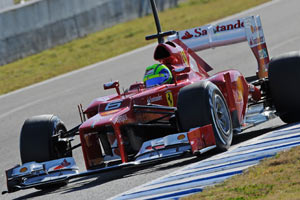Chuckjr wrote:Postmoe wrote:That situation ultimately led to a non diffuser-sealed car with poor rake and an enourmous amount of drag, pitch sensititvity and no rear DF at low speeds. That is consistent with the high drag and low rake theory. The car has a bad gasses extraction in the rear and it simply won't work at low speeds, when the wing DF is also poor and dependent on how the car is switching its CoG and its DF CoG.
It seems to me data in Oz was crucial, as their handmade approach gave some results and they decided to make a big step in three thirds during three races, acording to surprisingly accurate twitter rumours.
I think that they will seal the diffuser at all means, because no car has reached a 2010-2012 superiority. What rivals have done is finding a decent level of DF in a straight way to have a good relative aero efficiency. Not a lot more.
That makes incredible sense. Thank you for that explanation.
You state that Ferrari are determined to seal the diffuser and no car has done this very well yet. This implies that in your view the Macca and Sauber solutions are not actually doing much by way of sealing and are just doing a real good job with basic aero and suspension sets? Should that indeed be the case, and Ferrari do indeed seal the diffuser (I believe I read in here the Acer ducts extend further down than any other solution by a large margin), how much improvement on track in time will this provide in your estimation?
Secondly, is that hope/determination the reason they are so convinced this design will come to them, and will offer a huge advantage later in the season?
Slow down, I don't make any estimations, won't do it and don't know anything about the real situation

I'm only trying to put the pieces of information we have in a logical way. The low rake stiff rear theory combined with the acer ducts area issues has for me a certain consistency as a hole explanatory theory. Ride control isseus (banned solutions early in pre-season) also has sense.
What I figure in my head is that the diffuser is able to work and thus be sealed at high speed, extracting efficently high energy flows and sucking the car rear axe down in a normal way. But when the car hardbrakes and tractions the DF is very inconsistent, the car stalls in the front and looses DF in the rear, the aero CoG, wich is different than the mechanical one, changes brusquely and the entry and exit of some turns is a nightmare. The car is a kart in these moments and that's why FA is almost competitive and Felipe don't. You don't have solid front axe grip with a kart, don't need it. You just slide being confident in your ability to find early traction in a neutral entry.
I don't know nor understand what Macca and Sauber have done, but it seems that their approach was more straight aerodynamically. Strangely their not so injected exhaust flows seems to fit. Why? I don't know. Perhaps because they don't burn, literally, the tyres. It's also important to remember that cooling in the F2012 shares exit with exhausts. Perhaps overcomplex interactions made the rear fluxes overcomplicated and unpredictable. What if the flows are sticking perfectly, like a tight dress, at high speeds but suddenly become floppy and loose when breaking? I'm specifically pointing towards the sidepods and their slight U shape.
That's were I feel the problem is.


